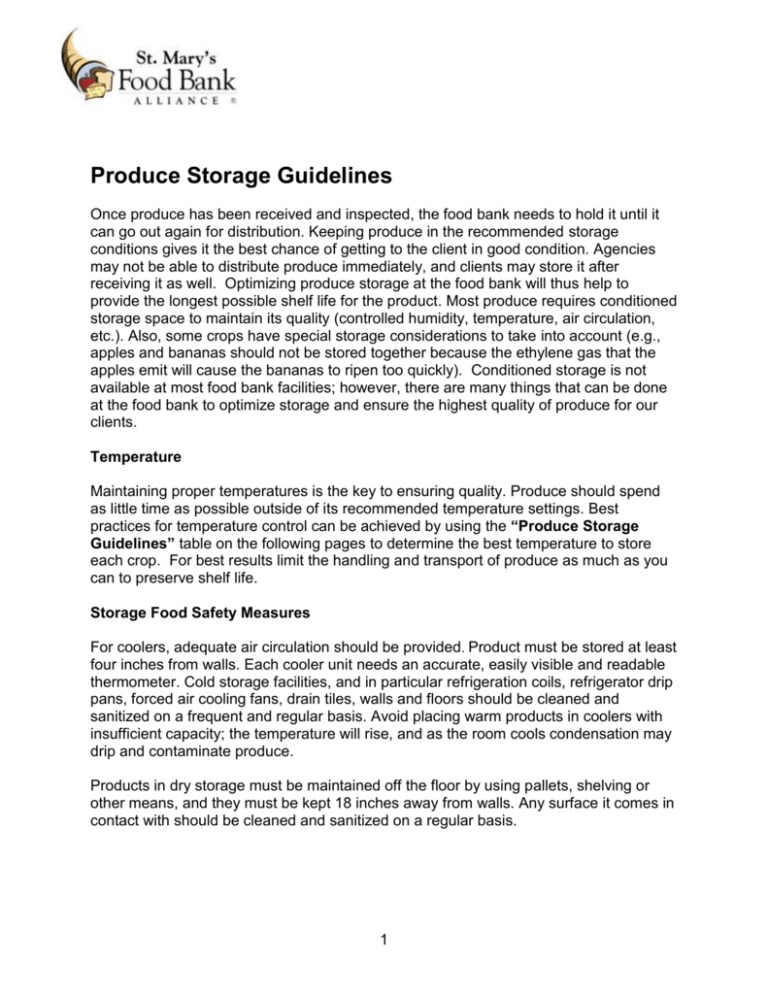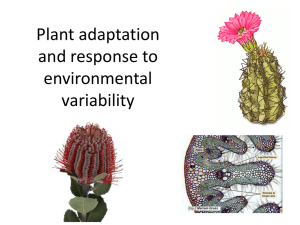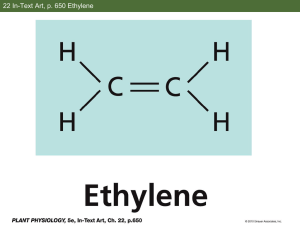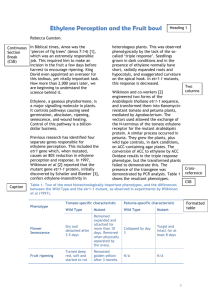Produce Handling Handout Materials
advertisement

Produce Storage Guidelines Once produce has been received and inspected, the food bank needs to hold it until it can go out again for distribution. Keeping produce in the recommended storage conditions gives it the best chance of getting to the client in good condition. Agencies may not be able to distribute produce immediately, and clients may store it after receiving it as well. Optimizing produce storage at the food bank will thus help to provide the longest possible shelf life for the product. Most produce requires conditioned storage space to maintain its quality (controlled humidity, temperature, air circulation, etc.). Also, some crops have special storage considerations to take into account (e.g., apples and bananas should not be stored together because the ethylene gas that the apples emit will cause the bananas to ripen too quickly). Conditioned storage is not available at most food bank facilities; however, there are many things that can be done at the food bank to optimize storage and ensure the highest quality of produce for our clients. Temperature Maintaining proper temperatures is the key to ensuring quality. Produce should spend as little time as possible outside of its recommended temperature settings. Best practices for temperature control can be achieved by using the “Produce Storage Guidelines” table on the following pages to determine the best temperature to store each crop. For best results limit the handling and transport of produce as much as you can to preserve shelf life. Storage Food Safety Measures For coolers, adequate air circulation should be provided. Product must be stored at least four inches from walls. Each cooler unit needs an accurate, easily visible and readable thermometer. Cold storage facilities, and in particular refrigeration coils, refrigerator drip pans, forced air cooling fans, drain tiles, walls and floors should be cleaned and sanitized on a frequent and regular basis. Avoid placing warm products in coolers with insufficient capacity; the temperature will rise, and as the room cools condensation may drip and contaminate produce. Products in dry storage must be maintained off the floor by using pallets, shelving or other means, and they must be kept 18 inches away from walls. Any surface it comes in contact with should be cleaned and sanitized on a regular basis. 1 Organizing Produce Storage Certain crops should not be kept in close proximity to other products. Some crops (like apples) emit ethylene gas, which causes ethylene-sensitive crops (like bananas) to ripen too quickly if exposed. Refer to the “Produce Storage Groupings” section of this handout for a list of crops by ethylene sensitivity. Produce should never be kept near chemicals, raw poultry, meat, or seafood. While in storage, produce should be checked daily (if not more often) to ensure that there are no new signs of damage, decay, or pest infestation and that it is being held in the proper temperature range. One way to integrate this with other warehouse activities is to check for produce quality while doing inventory level checks. Documenting and coordinating checks will help make operations more efficient. Ethylene* sensitive Ethylene* producers BANANAS BEANS, SNAP/GREEN BROCCOLI CABBAGE CARROTS CAULIFLOWER CUCUMBERS HONEYDEW MELONS LETTUCE WHOLE LETTUCE LEAF OKRA ONIONS, BULB PEPPERS, BELL SQUASH SWEET POTATOES WATERMELONS APPLES CANTALOUPE PEACHES PEARS PLUMS *Ethylene is a gas that causes many fruits and vegetables to ripen. Certain crops are particularly sensitive to it, while others produce large quantities of it. Ethylene sensitive crops should never be stored or transported with ethylene producers. 2 Produce Storage Guidelines BEANS, SNAP/GREEN STORAGE TEMP (°F) 32-34 56-58; to ripen 6065 40-45 PRODUCT APPLES BANANAS ETHYLENE SENSITIVE N ETHYLENE PRODUCER Y ODOR SENSITIVE Y ODOR PRODUCER N SUSCEPTIBLE TO FREEZING Y Y N N N Y N N N N Y BEANS, LIMA 37-41 Y N N N Y BERRIES, BLACKBERRIES 32-34 N N N N Y BERRIES, BLUEBERRIES 32-34 N N N N Y BERRIES, STRAWBERRIES 32-34 N N N N Y BROCCOLI 32 Y N N N Y N CABBAGE 32 Y N Y N CANTALOUPE 36-41 N Y N N Y CARROTS 33-35 Y N Y N N CAULIFLOWER 32 Y N N N N CELERY 32-36 N N Y N N CORN 34-38 N N Y N N CUCUMBERS 45-50 Y N N N Y MIXED FRUIT, FRESH CUT 33-41 N N N N Y GRAPES N N Y Y Y Y N N N N HONEYDEW 30-32 CA and AZ: 50-55; FL and TX: 50-60 45-50 N N N Y Y LEMONS 45-48 Y N N N Y LETTUCE WHOLE 34-36 Y N N N Y LETTUCE LEAF N N N N N N N N N N OKRA 34-36 31-32; to ripen 5177 43-45 Y N N N Y GRAPEFRUIT NECTARINES ONIONS, BULB 40-60 Y N Y Y Y ONIONS, GREEN 32 N N N Y N ONIONS, SWEET 45-55 FL: 32-34; CA: 4548; AZ & TX: 32-48 In-transit: 32-34; Receiving 57-77 32; To ripen 60-70 N N Y Y Y N N N Y Y N Y N N Y N Y Y Y Y 45-50 Green: 50-55; Ripe: 45 In-transit: 32-34; Receiving 51-77 45-50 Y N N Y Y N N Y N Y N Y N N Y N N Y Y Y N N N N N Y N N N Y SWEET POTATOES 33 Soft: 41-50; Hard: 50-55 55-60 Y N N N Y TOMATOES 62-68; Ripe 55-60 N N N N Y WATERMELONS 50-60 Y N N N Y ORANGES PEACHES PEARS PEPPERS, BELL PINEAPPLES PLUMS POTATOES SALAD MIXES, FRESH CUT SQUASH 3 Produce Storage Temperature Groupings Very cold group: 32-38°F Cold group: 45-50°F Cool group: 55-65°F APPLES BEANS, LIMA BERRIES, BLACKBERRIES BERRIES, BLUEBERRIES BERRIES, STRAWBERRIES BROCCOLI CABBAGE CANTALOUPE CARROTS CAULIFLOWER CELERY CORN GRAPES LETTUCE LEAF LETTUCE WHOLE MIXED FRUIT, FRESH CUT NECTARINES ONIONS, GREEN PEACHES PEARS PLUMS SALAD MIXES, FRESH CUT BEANS, SNAP/GREEN CUCUMBERS GRAPEFRUIT HONEYDEW MELONS LEMONS ONIONS, SWEET ORANGES OKRA PEPPERS, BELL PINEAPPLES POTATOES SQUASH WATERMELONS BANANAS ONIONS, BULB SWEET POTATOES TOMATOES These cooler space groupings are meant to help organize storage for coolers at food banks, not to be taken as an exact indication of recommended storage temperature for each product. For precise temperatures by product, check the “Produce Storage Guidelines.” 4 Produce Sorting Once the produce arrives at the food bank, it is often sorted by volunteers. This sorting generally serves one (or both) of the following purposes: 1. Culling Volunteers will sort produce by hand to ensure that moldy or otherwise unusable produce is disposed of. The need for culling depends on how fast the food bank typically distributes produce as well as what percentage of the produce is usable when it comes in. For food banks that have extremely fast turnover (same day or next day from receiving), culling is not as important as for food banks that may have to store produce for longer periods of time. 2. Repack The need for repack depends largely on program and agency capacity. Many programs and agencies do not have the capabilities to handle full pallets of produce. Programs that distribute to seniors and children, for example, may need their produce to be placed into small packs (e.g., 3 lb. bags). Programs that distribute to families often can handle slightly larger packs. Regardless, programs that involve handing small quantities of produce to individuals or families will generally require repack. Practical tips for volunteer sorting Sanitary practices Make sure anyone sorting is in good health (not sick with a cold or flu-like symptoms). Sorters should wash hands with soap and warm water for 20 seconds before sorting and when returning from breaks; preferably, dry hands with paper towels. Sorters should put on a hair restraint (hairnet, bandana, or hat) before sorting. Sorters should use disposable food-service grade gloves. For very dusty crops like potatoes or sweet potatoes, you can use masks and disposable aprons to avoid breathing in dust and dirtying clothes. After finishing the sort, wash and sanitize all surfaces that were used, especially tabletops. o Sweep floors and inspect for spills; clean floors with sanitizing solution as necessary. o Thoroughly wash and sanitize sinks. o Wash, rinse and sanitize all equipment used. 5 Physical safety tips Use safe lifting techniques when carrying heavy objects (e.g., lift with legs and not back). Avoid heavy work for volunteers that have health issues that will become aggravated. Make sure volunteers stay hydrated and take breaks as needed. Keep volunteers out of the way of potentially dangerous warehouse equipment like forklifts. General recommendations If you find a moldy item, do not sniff it because of potential respiratory issues; remove and place in scrap receptacle. Always minimize the time produce spends outside of ideal storage conditions. Show volunteers acceptable vs. not acceptable blemishes to help understand what produce should be thrown away (refer to PowerPoint presentation for examples) Do not overfill repack containers or bags. Composting rejected produce is an alternative to discarding it. FEFO or FIFO FEFO stands for First Expiry, First Out. It is an inventory management practice for perishable goods that will minimize spoilage. Using FEFO means that the produce that will expire the soonest needs to leave the warehouse the soonest. For instance, there could be shipments of potatoes and strawberries received on Monday. However, during the receiving inspection, the strawberries are assigned an expiration date of that Wednesday, while the potatoes are assigned an expiration date of the following Monday. Despite the fact that the potatoes and strawberries came in at the same time, the strawberries should leave earlier because of their shorter life span. To use FEFO, make sure to assign, label, and document an expiration date for produce when it is first received. The expiration date assessment should be based on the product’s typical life span as well as its condition upon receiving. FIFO stands for First In, First Out. Using this practice, whatever comes in to the warehouse first should leave soonest. FEFO is highly preferable to FIFO for produce, due to examples like the one just mentioned above. However, FEFO may also be harder to implement because estimating product life span can be a difficult task. Daily inspection of all produce on hand can help support FEFO decisions. 6 Apples Receiving and Inspecting: Apples should be firm and have smooth skin. Storing and Handling: Apples should be stored at 32-34°F. Susceptible to freezing; do not store below 29°F. Sensitive to ethylene: No Produces ethylene: Yes Acceptable Superficial spot Bruises Not acceptable Blue mold Gray mold Alternaria rot Bull’s eye rot 7 Bananas Receiving and Inspecting: Avoid fruit with damaged skins. Storing and Handling: Bananas should be stored at 56-58°F. To ripen green bananas, store at 60-65°F. Bananas bruise easily; handle with care. Sensitive to ethylene: Yes Produces ethylene: No Acceptable Slight speckling A few bruises Not acceptable Chill damage Overripe 8 Cabbage Receiving and Inspecting: Cabbage should be fairly even colored and heavy for its size. Storing and Handling: Cabbage should be stored at 32-36°F. Sensitive to ethylene: Yes Produces ethylene: No Acceptable Small spots on outer leaves Not acceptable Black rot White rot Downy mildew 9 Cantaloupe Receiving and Inspecting: Cantaloupe should be round with good netting or webbing over creamy-colored rind. They have a distinctive aroma and the blossom end will yield to gentle pressure when ripe. Storing and Handling: Cantaloupe should be stored at 36-41°F. Susceptible to freezing; to prevent chill injury, do not store below 30°F. Sensitive to ethylene: No Produces ethylene: Yes Acceptable Slight discoloration Not acceptable Decay Mold Anthracnose 10 Carrots Receiving and Inspecting: Carrots should have firm, smooth exteriors (should snap when bent far enough). Color should be vibrant orange to orange-red. Storing and Handling: Carrots should be stored at 33-35°F. Do not store below 30°F. Sensitive to ethylene: Yes Produces ethylene: No Acceptable Spots on outer surface Odd shapes Not acceptable Rot Mold More rot 11 Lettuce Receiving and Inspecting: In general, avoid wilted and discolored leaves. For iceberg lettuce, some browning of the core end is natural and occurs from oxidation after lettuce has been harvested and trimmed. Storing and Handling: Lettuce should be stored at 34-36°F. Keep lettuce away from drafts to avoid dehydration. Sensitive to ethylene: Yes Produces ethylene: No Acceptable Tear/slight bruising Brown core Not acceptable Wilted leaves Translucent leaves (freeze damage) 12 Onions (bulb) Receiving and Inspecting: Good quality onions should be firm and hard with short, tight necks and dry papery skin. Slightly loose outer skin is common and should not affect quality. Storing and Handling: Onions should be stored at 40-60°F. For extended storage (longer than 7 days), hold at 32-36°F. Keep out of direct sunlight. Sensitive to ethylene: Yes Produces ethylene: No Acceptable Small sprouts Unusual shape Not acceptable Bulb rot Bacterial soft rot Neck rot Sour skin 13 Oranges Receiving and Inspecting: Oranges should be firm, heavy for size, and have fine-textured skin. Skin color of a ripe orange ranges from orange to greenish-orange. Many oranges go through a regreening process on the tree in which the skin color begins to turn from orange back to green again. Regreening is a natural occurrence and does not affect the flavor quality of the orange. Storing and Handling: Optimal storage temperature varies by type. FL: 32-34°F; CA: 45-48°F; AZ & TX: 32-48°F. Sensitive to ethylene: No Produces ethylene: No Acceptable Slightly green oranges Small spots Not acceptable Mold Mold in navel Stem end decay More mold (green) 14 Potatoes Receiving and Inspecting: All potato varieties should be fairly clean, firm, and smooth. Avoid potatoes with wrinkled skins, soft dark spots, or green appearance. Storing and Handling: Potatoes should be stored at 45-50°F. Susceptible to freezing; to prevent chill injury, do not store below 42°F. Sensitive to ethylene: No Produces ethylene: No Acceptable Small peepers (sprouts) Odd lumps Not acceptable Moldy cut Green potato (solanine) Common scab Late blight 15 Tomatoes Receiving and Inspecting: Good quality tomatoes should have bright, shiny skin and firm flesh. Storing and handling: Ripe (nearly full red) tomatoes should be stored at 55-60°F; less ripe tomatoes should be stored at 62-68°F. Sensitive to ethylene: No Produces ethylene: No Acceptable Greenish tint Slight dent Not acceptable Black rot Moldy bruise Late blight Mold and bruising 16 Watermelon Receiving and Inspecting: Watermelons should be firm. Watermelons do not ripen after harvesting; a ripe watermelon will produce a distinct hollow sound when thumped. Storing and Handling: Watermelons should be stored at 50-60°F. Susceptible to freezing; to prevent chill injury, do not store below 41°F. Sensitive to ethylene: Yes Produces ethylene: No Acceptable White/yellow patch Small spots Not acceptable Decay Anthracnose Fruit blotch 17








